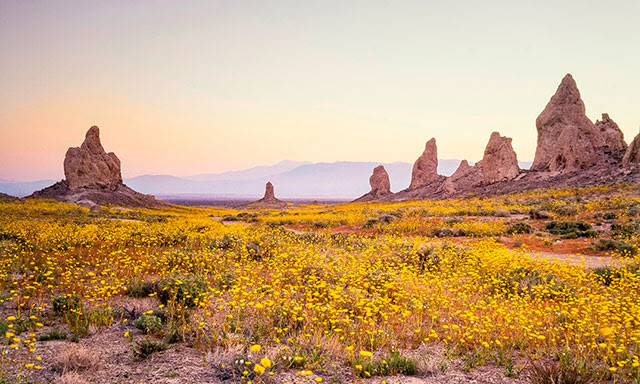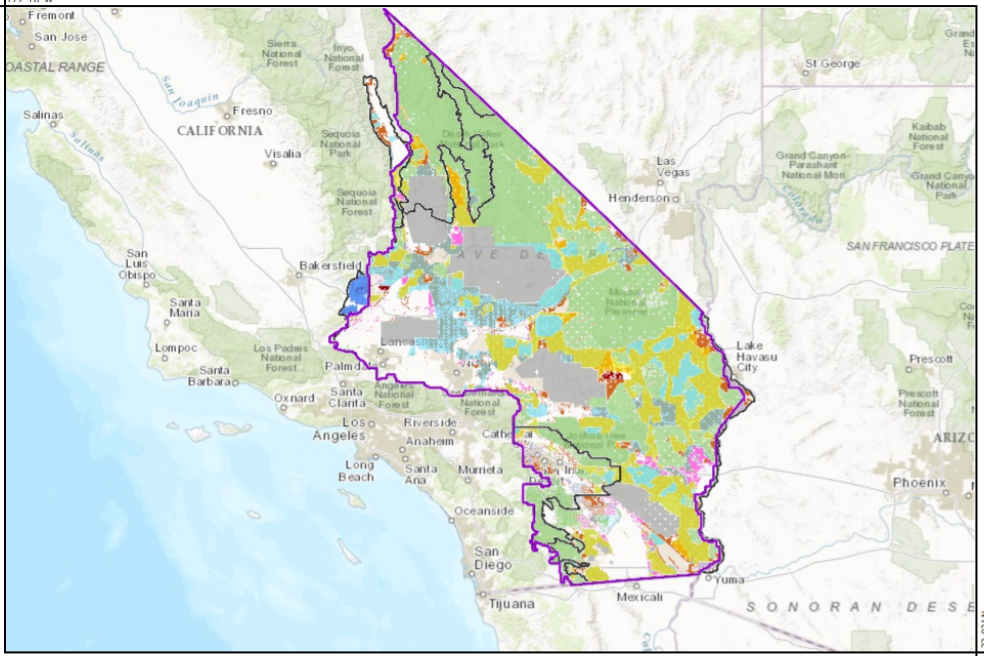
The Trona Pinnacles and other beautiful places in the CA desert should be preserved, not developed. Photo courtesy John Dittli.
The Trump Administration has launched another blatant attack on Conglomerate Mesa and other special desert lands in Inyo County (and six other counties in California) including the Amargosa Basin. But it doesn't stop there. No matter where you live, these are your federally managed lands. Please weigh in.
The Administration is also targeting important protected habitats, recreation areas, and cultural sites on Bureau of Land Management (BLM) public lands in 6 other counties: Imperial, Kern, Los Angeles, Riverside, San Bernardino, and San Diego. Trump's Interior Department and Secretary Zinke are attempting to roll back important protections found in the BLM's Desert Renewable Energy Conservation Plan (DRECP), which was finalized in 2016 after an extensive 8-year cooperative effort between the California Energy Commission, California Department of Fish and Wildlife, the U.S. Bureau of Land Management, and the U.S. Fish and Wildlife Service. The plan, although imperfect, balances land conservation and outdoor recreation with the growing demand for clean energy on 10.8 million acres of public lands in the California desert.
Now the Trump Administration is exploring wholesale changes to the DRECP that could open special, protected and environmentally sensitive areas like the Panamint Valley - which is currently designated for conservation and recreation - to industrial scale renewable energy, mining, and other development projects. The BLM's DRECP revision announcement emphasizes, "increasing opportunities for increased renewable energy development, recreational and off-highway vehicle (OHV) access, mining access, and grazing." The Administration is also targeting currently protected Areas of Critical Environmental Concern (ACEC), such as Fossil Falls, which highlight and safeguard areas where special management is needed to protect important historical, cultural, biological and scenic values.

A map from the BLM's final EIS. View this map with better resolution, legends, etc., by clicking here.
The development of the DRECP involved extensive public meetings and comment opportunities across seven counties in the California desert and also included input from Inyo Board of Supervisors and other county governments, state agencies, Native American tribes, renewable energy developers, OHV groups, electric utilities, and conservation organizations.
Through careful scientific analysis, the final DRECP identified areas that may accommodate renewable energy projects and associated transmission over the next 25 years on 388,000 acres of the desert, an area the size of Los Angeles. The plan also protected 4.2 million acres of the California desert's most sensitive natural and cultural landscapes and designated 3.6 million acres for a diverse array of motorized and non-motorized recreational activities.
The DRECP was the result of years of collaborative work, scientific analysis, public participation and compromise. Sixteen thousand public comments were submitted during DRECP planning, with the majority asking for more conservation, not less. Ultimately, the DRECP provided protections for Conglomerate Mesa, Panamint Valley, the Amargosa River and Amargosa Basin, Fossil Falls, Centennial Flats, the Trona Pinnacles, and other special desert lands in Inyo County and across the desert. Opening these lands to mining and industrial-scale development would destroy these places and limit public access. Our desert communities that rely on outdoor tourism and recreation would also suffer.
The Sierra Club, Friends of the Inyo, Amargosa Conservancy, INYO350, State of California, Senator Dianne Feinstein, and other allies and partners are united in the position that the Trump Administration should leave the DRECP alone.
Your help is needed today! Here's what you can do:
Write a comment letter to the BLM.
Tell the BLM to leave the DRECP alone. Comments may also be submitted until March 22, 2018, to the BLM-California State Director, 2800 Cottage Way, Rm W-1623, Sacramento, CA 95825, or electronically to BLM_CA_DRECP@blm.gov.
Here are some talking points:
- The Trump administration is taking aim at the California Desert by reopening a landmark plan that set aside extensive public lands for conservation and recreation while carefully allocating a smaller portion of lands for renewable energy development to help meet the State’s renewable energy needs. The Desert Renewable Energy Conservation Plan (DRECP), eight years in the making, was a true collaborative effort by the State of California and Bureau of Land Management (BLM), with full engagement from the public and desert counties including Inyo County.
- Please tell Inyo County and the BLM that you support the DRECP as is and you oppose reopening this plan. Ask the BLM to focus its efforts on managing the California desert and implementation of the plan. Talk about special places in Inyo County or elsewhere in the California desert you love to visit and why you want to see them protected.
- The DRECP was a multiple-year, collaborative effort. Inyo County and its residents were actively involved in the DRECP. DRECP agencies including the State of California and the BLM traveled numerous times to Inyo County and held multiple meetings and workshops in collaboration with the County.
- Thank Inyo County for the extensive work it put into the DRECP and the County’s Renewable Energy Amendment to the General Plan (REGPA) which ensured places like the Owens Valley would not be developed with wind turbines and the Amargosa region would not be developed with solar power towers. Ask Inyo County to “stay the course” by continuing to support the DRECP without changes.
- The DRECP protects a large swath of CA desert lands, including important plant and animal habitats and diverse recreation areas, from industrial-scale renewable energy development. The DRECP ensured that lands in Inyo County such as Conglomerate Mesa, Panamint Valley and the Amargosa Region will be preserved and can continue to be enjoyed as they are today.
- The plan supports multiple use recreation, both motorized and nonmotorized, through land use designations such as conservation lands and recreation management areas. All of the lands designated in DRECP are open to public access and all existing off-road routes remain open.
- The DRECP has not removed any lands from mining activity. All existing and future mining rights are preserved.
- Outdoor tourism on lands the DRECP protects for conservation and recreation are powering our rural desert economies, and the DRECP ensures they will continue to do so by preventing industrial-scale renewable energy development in inappropriate places.
- The DRECP is not perfect but it was fully vetted, and represented a compromise for all stakeholders. To open this plan now, when it was never litigated, is a tremendous waste of time and taxpayer dollars, and will cost Inyo County additional money and staff time that can be better spent moving the County forward instead of going backward.
- For those who live in Inyo County and the rest of the desert, preserving the DRECP is about preserving our quality of life –we don’t want to see our beautiful lands inappropriately developed.
- Reopening the DRECP could result in massive development of industrial-scale renewable energy and other development on public lands. Not only is this development not needed to help CA meet its renewable energy needs, it results in great uncertainty for ALL desert residents and users.
- Let’s not throw the plan out without giving it a chance to work!